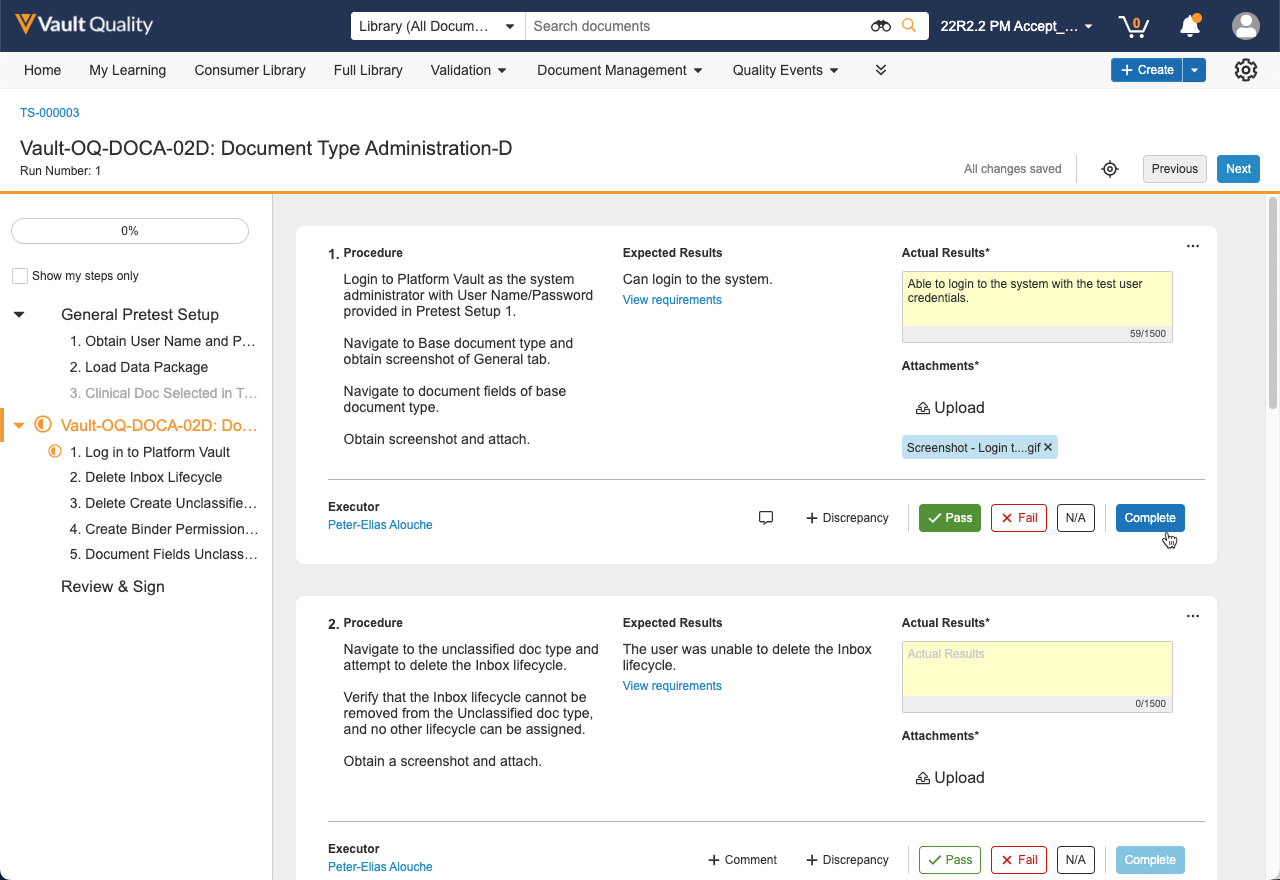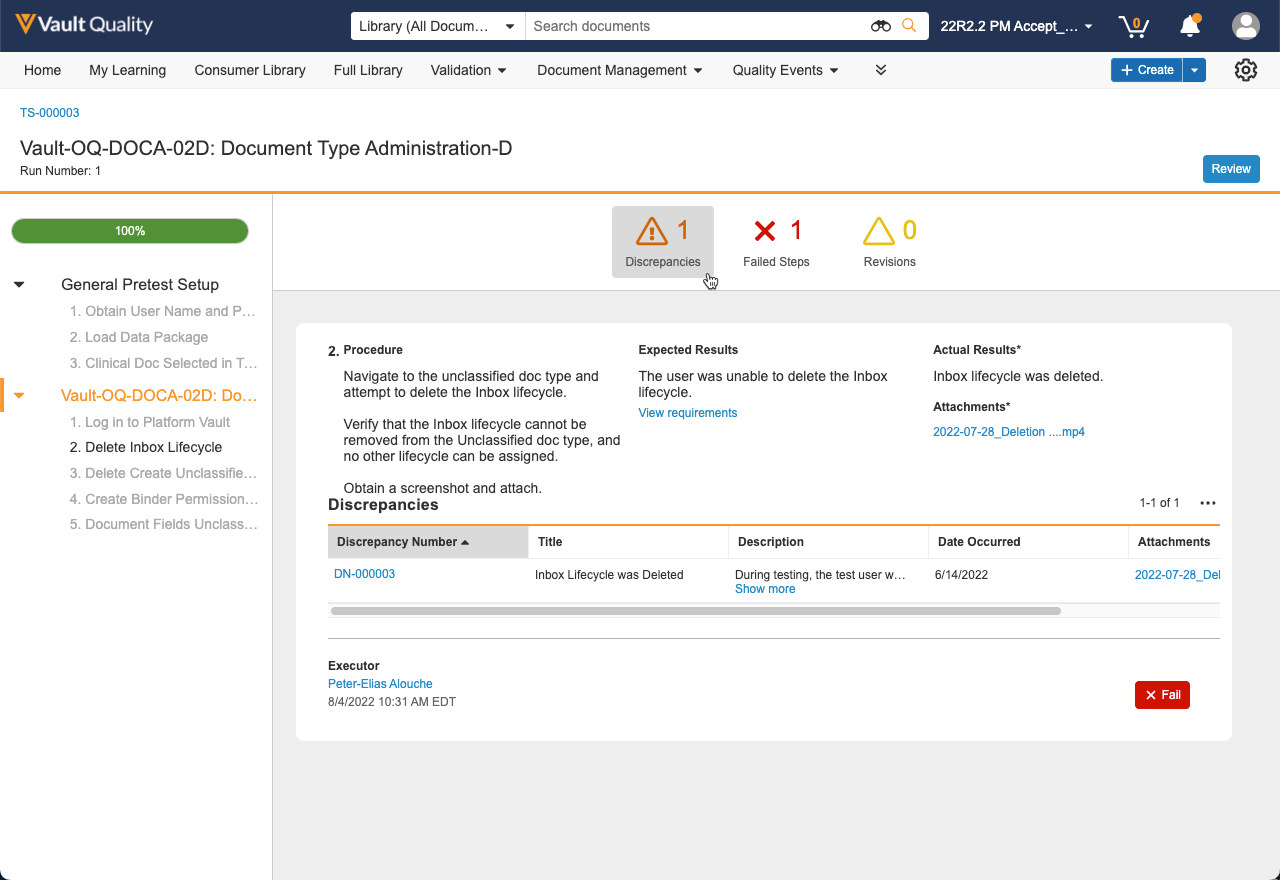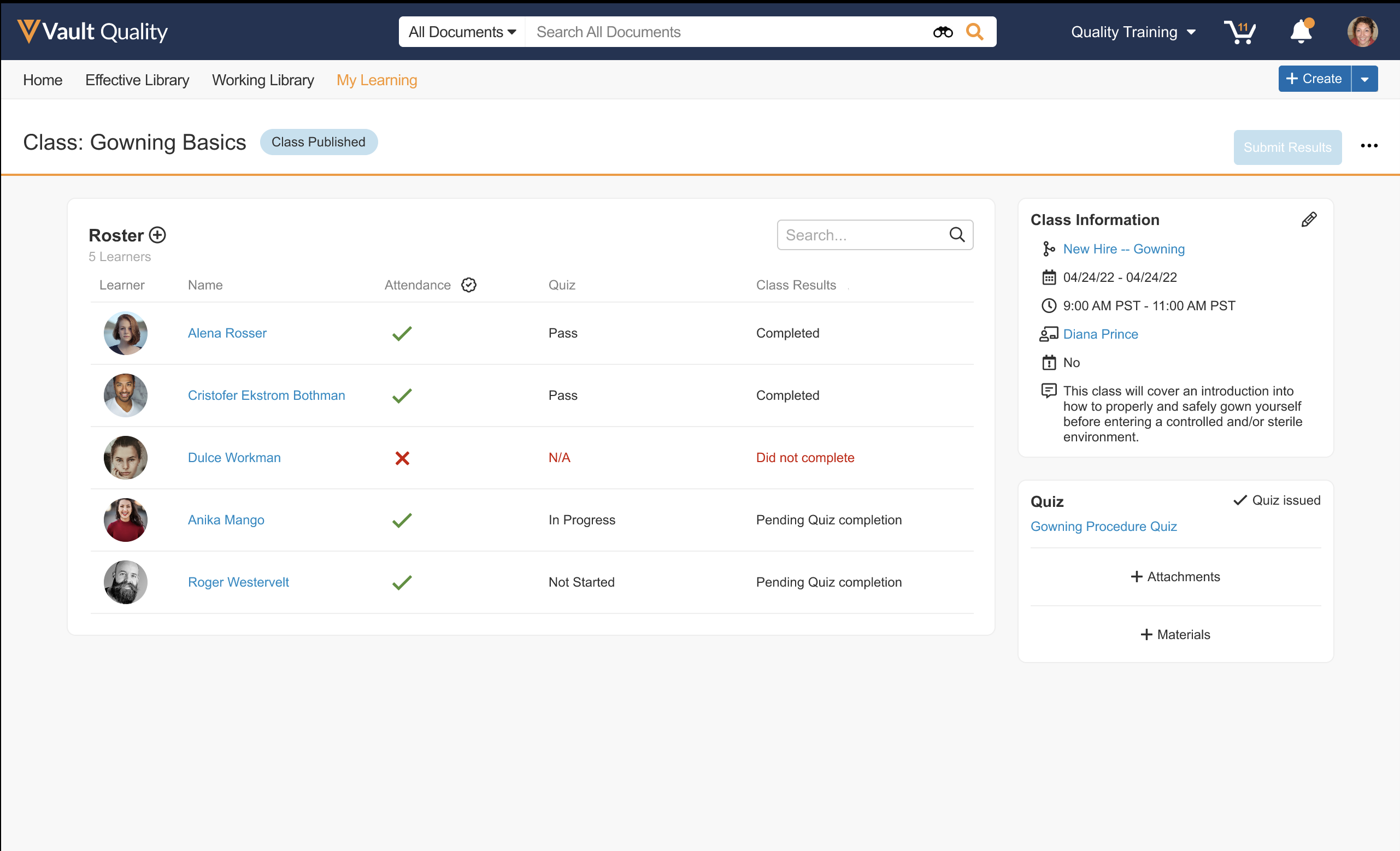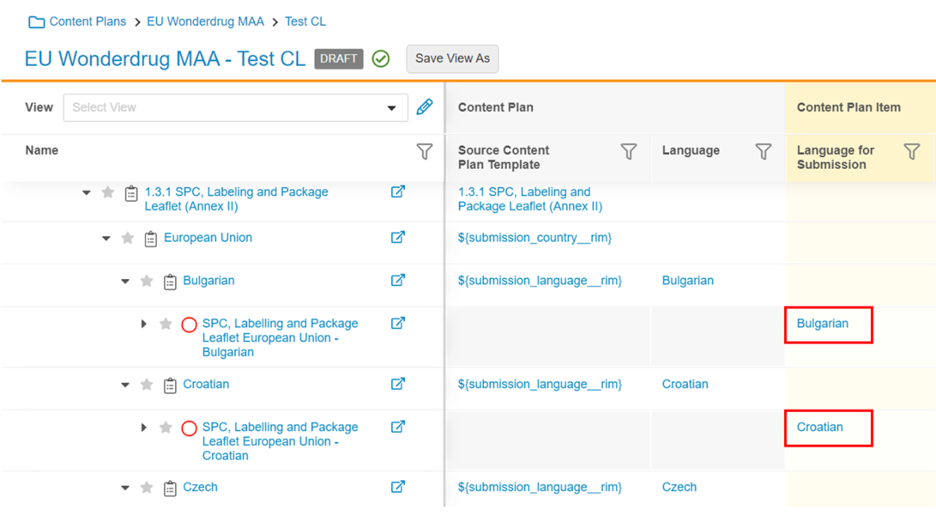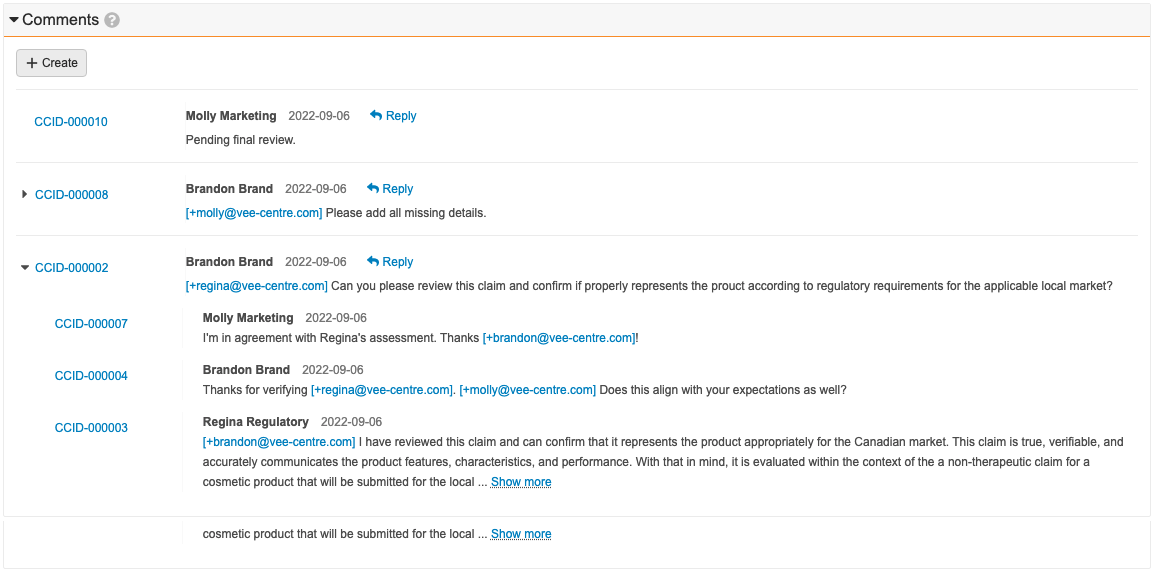Pre-Release 日: 2022 年 10 月 31 日 | リリース日: 2022 年 11 月 18 日および 2022 年 12 月 2 日
Vault 22R3 のご紹介です。以下の新機能をご覧ください。新機能の有効化に関する情報については、22R3 Release Impact Assessment をご覧ください。開発者向け機能 (API、VQL など) については、Developer Portal をご覧ください。
Platform
ドキュメントでの作業
用語集
この機能を使用すると、ドキュメント内のテキストを選択して、承認済み用語集にある定義を検索できます。また、用語と定義をクリップボードにコピーして、簡単に共有することもできます。管理者は、Glossary Events オブジェクトを使用して、用語集アクティビティの表示やレポート作成を行うことができます。管理者は、ユーザが検索できる外部検索エンジンを設定することもできます。詳しくは、用語集をご覧ください。
ドキュメントのグリッドレイアウトでヘッダーおよび列を固定する
グリッドレイアウトでドキュメントの検索結果を表示する場合、列のヘッダーを固定して、縦スクロールしても常に表示されるようになりました。また、任意で列を固定して、横方向のスクロール時に常に表示されるようにすることもできます。
単一/一括ドキュメント/オブジェクトレコードでの添付ファイルレンディションの無効化
レンディションサーバーの負荷を軽減しユーザエクスペリエンスを向上させるため、Vaultでは、ドキュメントおよびオブジェクトレコードの添付ファイルレンディションがオンデマンドでレンダリングされるようになりました。
OCR の言語対応の拡張
今回のリリースでは、Vault の光学文字認識 (OCR) サポートが拡張され、英語以外のテキストを含むファイルがサポート対象に追加されました。管理者は、ドキュメントの再レンダリング時にドキュメント言語を選択することもできます。
エクスポートしたバインダー: 監査証跡ファイルの命名
今回のリリースでは、ユーザが監査証跡付きのバインダーをエクスポートする際、Vault はエクスポートされた最新バージョンに基づいて監査証跡ファイルに名前を付けるようになりました。以前のリリースでは、Vault はエクスポートされた最も古いバージョンに基づいてファイル名を付けていました。
監査証跡におけるドキュメント関連の構成設定の追跡
今回のリリースでは、ドキュメントに関連するすべての構成設定に監査イベントを含め、システム監査履歴で表示されるようになりました。
- エクスポートするファイル名の最大文字数 (拡張子を含む)
- エクスポートするフォルダ名の最大文字数
- エクスポートするドキュメントパスの最大文字数
アウトラインビューの確認ダイアログでバインダーにセクションを追加
アウトラインビューでバインダーにセクションを新規追加すると、確認ダイアログでセクション名が入力されるようになりました。この UI 変更は、コンパクトビューでバインダー内のセクションを新規追加する方法と一致しています。
署名ページ生成におけるエラー処理の改善
今回のリリースでは、Vault は署名ページのダウンロード時に詳細テンプレートのレイアウトを検証し、すべての署名が明示可能であるかを確認するようになりました。テンプレートの署名ブロックに最大行数が設定されており想定されている署名数を超えている場合、エラーがトリガーされます (管理者に問題対処を求めるメッセージが表示されます)。
ユーザメンション通知の送信を新規ユーザメンションの場合に限定
22R1 では、ノートへの返信に関する通知機能の一部として、ユーザメンション通知が送信される条件を更新しました。Vault では、ユーザメンションがすでに存在する既存のメモや返信を編集した場合には、ユーザメンション通知が送信されなくなりました。Vault でユーザメンション通知が送信されるのは、新規ノートまたは既存ノートにユーザメンションが追加された場合のみです。
Vault オブジェクト
大容量オブジェクトの Lookup フィールド
大容量オブジェクト (HVO) で lookup フィールドがサポートされるようになりました。ただしこの lookup フィールドは、標準容量オブジェクト (SVO) と比較して、ファセット、フィルタリングおよび並べ替えに制限があります。
ライフサイクルとワークフロー
複数レコードのワークフロー
この機能により、同じワークフロー上で複数のレコードを送信できるため、生産性とタスク参加者のユーザエクスペリエンスが向上します。管理者はワークフロー定義時に、同じオブジェクトのレコードを最大 100 件含められるようになりました。また、管理者は既存のワークフローを有効化して複数のレコードを含めることもできます。
マルチドキュメントビューアの UI 更新
この機能により、ワークフロー内にあるマルチドキュメントビューアのユーザエクスペリエンスが向上します。タスクの判定を収集するダイアログが、バックグラウンドで実行されるページネーションとドキュメント表示をサポートするようになりました。左側のサイドバーで、ドキュメントリストのフィルタリングと無限スクロールがサポートされるようになりました。
ワークフローのタスク参加者数制限
管理者は、この機能を使用すると、ワークフローの開始手順で定義済みの各参加者コントロールごとに選択可能な最大参加者数を定義できます。この機能を有効にすると、ユーザが誤って大人数のユーザグループ (例: すべての内部ユーザ) にタスクを割り当ててしまう事態を防止することができます。
ドキュメントワークフロー内のフィールドプロンプトに対する値の事前入力
Vault では、関連するドキュメントフィールドに値が存在する場合、単一ドキュメントのワークフローにおける「開始」手順および「タスク」手順のフィールドプロンプトおよび単一の判定プロンプトに、当該ドキュメントフィールドの値が事前に入力されるようになりました。
レポート作成とダッシュボード
オブジェクトレポートタイプのあるドキュメント
この機能により、各種ドキュメントとそれに関連するオブジェクトレコードに関するレポートを作成できます。管理者は、レポートタイプのプライマリオブジェクトを「ドキュメント」に設定した際に、そのレポートタイプに別のオブジェクトを上位/下位関係を付けて追加できるようになりました。Vault では、「ドキュメント」レポートタイプへの単一値または複数値の送信関係を追加できます。ドキュメントフィールドで参照されるオブジェクトは、フィールドが単一値の場合は上位オブジェクトとして、またフィールドが複数値の場合は下位オブジェクトとして、オブジェクト関係を表示します。
コントロールチャート
この機能を使用すると、レポートデータをコントロールチャートとして表示できます。コントロールチャートは、他のダッシュボードチャートと同様に、グループ分けを 1 つ以上含むレポートを使用して生成できます。Vault で自動的にシグマ計算が実行され、計算結果がチャート内でハイライト表示されます。履歴データと比較するための目標線を手動で追加することもできます。
レポート内 HVO Lookup フィールドのサポート
この機能を使用すると、レポート内の検索可能な HVO Lookup フィールドをフィルタリングできます。Lookup フィールドは、検索可能か検索不可能かに関係なく、すべてレポートの列として追加できます。また、すべてのフィールドは、標準レポートのグループ化にも使用できます。さらに、マルチパスレポートに制限はありません。
検索およびフィルタ
動的タブでのビュー保存
関連リストで [タブに表示] オプションを使用する場合、その動的タブ内のビューに検索条件を保存できるようになりました。保存したビューは、当該関連リストにアクセスできる他のユーザと共有できます。
高精度なハイライト機能
検索結果内の検索語句をハイライト表示する機能では、検索ボックスに入力した語句と完全一致しない検索語句も太字表示されるようになりました。ステミングにより該当した検索結果には、入力した元の単語の活用形が結果内でハイライト表示されるようになりました。たとえば、「early」という語で検索した際に「earlier」という語を含むドキュメントが該当した場合、検索結果では「earlier」が太字表示されます。
また、この更新では、同義語としてヒットした単語も強調表示されます。この場合、「IB」という単語を検索すると、シソーラスに「IB」の同義語が登録されていれば、検索結果には「investigative brochure」が太字表示されます。
ドキュメントコンテンツのインデックス再構成
Vault 検索エンジンへのアップグレードに備えて、現在すべてのドキュメントのコンテンツインデックスを再構成中です。このインデックス再構成はリリース後に行われるため、以下に説明する変更はリリース後すぐには確認できません。この再構成作業は数週間かけて行われます。
インデックス再構成が完了すると、Vault ではドキュメントコンテンツの検索時に英語用ステミングが追加され、検索時に複数名詞 (report と reports)、動詞の時制 (injecting と injected)、および比較級 (early と earliest) が自動的に置換されるようになります。
長期間にわたってインデックスの再構成が行われておらず OCR プロセスを行う必要のある古いドキュメントに関しては、Vault の最新 OCR プロセスの信頼度によって、検索可能な語句が異なる場合があります。つまり、このようなドキュメント内における検索可能語句の数は、OCR 信頼性基準値に基づいて上下する可能性があります。
処方
数式でのオブジェクト参照フィールド
この機能を使うと、Vault の式にオブジェクト参照フィールドを使用できるようになります。オブジェクト参照フィールドを Text() 関数や ID() 関数でラップして、レコードラベルもしくは ID をそれぞれテキストとして返すことができます。Text() 関数または ID() 関数でラップされていないオブジェクト参照フィールドは、オブジェクト参照を直接返します。既に使用している (レコード ID またはレコードラベルをテキストとして返す)オブジェクト参照フィールドからは、引き続き同じ値が返されます。
Currency Formula フィールド
この機能は、object formula フィールドに formula フィールドタイプと currency を導入するものです。Currency formula フィールドは、企業通貨または現地通貨の形式に則った数値データを返します。
チェックリスト
チェックリスト: アドホックセクション
この機能により、管理者はチェックリストの設定時に、回答者がランタイムチェックリストにセクションをアドホックに追加できるようにすることができます。
UI とユーザビリティの更新
エンタープライズホームページ: 新規グリッドビュー
今回のリリースで、Vault エンタープライズホームページ (別名 [マイ Vault] ページ) で、現在のカードビューに加えて新しいグリッドビューが利用可能になりました。ユーザは、新しいグリッドビューと更新されたカードビューを切り替えることができます。グリッドビューでは、多数の Vault にアクセスできるユーザに検索と並べ替え機能を提供します。また、Vault セレクタの選択リストとエンタープライズホームページのカードビューおよびグリッドビューには、Vault が使用できない場合に、メンテナンスモードまたは構成モードになっているかが表示されるようになりました。
新しいエンタープライズホームページは、Limited Release Vault にアクセスできるユーザにのみ表示されます。22R3.0 のホームドメインで [マイ Vault] ページが有効になっている場合は、全ユーザに表示されます。
エンタープライズホームページ: カードビューのデザイン変更
今回のリリースでは、エンタープライズホームページのカードビューで表示されるユーザインターフェースが強化され、ユーザは開くべき Vault を素早く見つけることができます。
22R3 新機能ページコンテンツの更新
「22R3.0 の新機能」ページのコンテンツを更新し、Vault をより素早く簡単に使用するために役立つ機能をいくつか紹介しています。
Administration
30 分間のアップグレード
本番環境の Vault はアップグレード処理に約 30 分間を要し、その間利用できなくなります。アクティブなユーザには、Vault が使用不可になる直前に通知が送られ、作業を完了する時間が与えられます。Vault のアップグレードが完了すると、通知領域に「新機能」のお知らせが表示されます。Sandbox Vault は、メンテナンスウィンドウの期間中は引き続き使用不可となります。
クエリ管理
Vault の安定性とパフォーマンスを確保するため、VQL では負荷の高い VQL クエリに対して強制的に制約が適用されるようになりました。この変更は API バージョン 22.3 以降に影響しますが、既存の統合には影響しません。詳細に関しては、Developer Release Notes をご覧ください。
編集可能な Vault 名
今回のリリースにより、管理者は Vault 全般設定ページ (Admin > Settings > General Settings) の Vault Name フィールドを編集できるようになりました。また、General Settings ページには Vault URL が表示されるようになりました。
通知: メール通知ステータス
この機能により、管理者は操作タブの新しいページでメール通知の配信ステータスを確認できるようになります。管理者は、メール通知の一覧を、日付、メールアドレスおよびステータス別にフィルタリングしたり、CSV 形式でエクスポートできます。
Vault データベースで通知を保持する期間は、2 年間のみに変更されました。2 年以上前の通知は、ZIP 形式の CSV ファイルとしてダウンロードできます。
Person オブジェクト: パーソンレコードの重複検出
この機能は、企業管理者タブまたは個別のパーソンタブでパーソンレコードを作成する際に、重複の可能性がある場合にユーザに警告することで、パーソンレコードの重複作成を検出するのに役立ちます。管理者は、設定タブで重複一致条件を確認および編集できます。
通知: 既読および未読ステータス
この機能により、各ウェブ通知に「既読」と「未読」のステータスが追加されます。ユーザは、通知パネルおよび通知ページから、未読の通知を「既読」としてマークできます。
送信パッケージ: グループデータ移行のサポート
今回のリリースで、構成移行パッケージおよびテストデータパッケージにユーザグループを含めることが可能になりました。構成でグループを参照できるようになり、グループをデータ手順に含めることができるようになりました。グループは、依存関係に従って処理および展開されます。
パーソンの送信メールアドレス
今回のリリースでは、送信メールドメインを使用する Vault アプリケーションで、Person レコードの送信メールアドレスを設定できるようになりました。
設定管理: 保留中のコンポーネント更新がある場合の Review & Deploy ページ上の通知
この機能により、「レビューおよび展開」手順中に保留中の設定変更がある場合にユーザに対して警告を発する、新しい警告メッセージが追加されました。Vault にこのメッセージが表示された場合、行った設定変更が同期されていないことを意味します。そのためユーザは展開手順を続行する前に、変更を完了させる必要があります。
テストデータパッケージ: デフォルト Reference Lookup フィールドの上書き
管理者は、テストデータパッケージの作成時に、オブジェクトのデフォルト参照ルックアップを、そのオブジェクトで使用可能な固有フィールドのいずれかで上書きできるようになりました。これまで、この機能は移行パッケージでのみ利用可能でした。
Vault 構成レポート内のアトミックセキュリティレポートに関する説明
Vault 構成レポートに、システムデフォルト以外のアトミックセキュリティのみが含まれる旨の説明が追加されました。システムデフォルト状態の動作は文書化されています。
スケジュールされているデータエクスポート
スケジュールされているデータエクスポート: 開始予定時刻の更新
今回のリリースでは、管理者は、スケジュールされているデータエクスポートジョブの開始時刻を変更および設定できるようになりました。
スケジュールされているデータエクスポート: 選択リストのラベルと名前
ドキュメント、ドキュメントバージョンおよびオブジェクトメタデータを対象としてスケジュールされているデータエクスポートに、選択リストの名前とラベルが含まれるようになりました。
スケジュールされているデータエクスポート: デフォルトのアルファベット順ドキュメントメタデータ
ドキュメントおよびドキュメントバージョンメタデータを対象としてスケジュールされているデータエクスポートで、デフォルト順序が列見出しのアルファベット順になりました。
アクセスコントロール
アクセス権の委譲機能: すべての Vault で有効化が可能に
今回のリリースでは、すべての Limited Release Vault でアクセス権の委譲機能が利用できるようになりました。General Release では、Vault 22R3.0 で有効化されます。
これまでに有効化していない場合、この機能はデフォルトで無効になっており、管理者が Admin > Settings > General Settings から有効化できます。
ドメインユーザ: UI の機能強化
数百もの Vault を含むドメインに対応できるよう、ドメイン管理のユーザインターフェース (Admin > Users & Groups > Domain Users) が改良されました。新機能には、Vault メンバーシップのインライン編集、改良されたメンバーシップ追加フロー、およびユーザの Vault メンバーシップをエクスポートする機能が含まれます。
システム管理ユーザ: メールとセキュリティポリシーの標準化
今回のリリース以降、システム管理ユーザには標準化されたセキュリティポリシー (システム管理) およびメール (no-reply@veeva.com) が適用されます。この変更は、Vault のプラットフォームおよびアプリケーション上のシステム管理ユーザに適用されます。
ユーザへの委任者の追加: パフォーマンスの最適化
この機能では、ユーザに委任者を新規追加する際のドロップダウン選択のパフォーマンスを最適化するものです。この機能は、多数のユーザを持つ Vault で特に役立ちます。委任者選択の最適化が進行中の場合、Active Delegations ページにバナーが表示されます。
Vault Java SDK
Vault Java SDK サービスアカウント
この機能により、Admin > Settings > General Settings に Run Custom Code as Java SDK Service Account 設定が追加されました。この設定は、Pre-Release Vault では使用できません。この設定が Vault で有効になっている場合:
- カスタムコードは、Vault 所有者レベルのアクセス権を持つ Java SDK サービスアカウントとして実行されます。
- デフォルトでは、カスタム SDK コードで作成されたオブジェクトレコードとドキュメントの所有者として Java SDK サービスアカウントが設定されます。
- Vault 拡張により影響を受けるドキュメントとオブジェクトレコードの監査ログエントリは、リクエストを開始したユーザに代わって、Java SDK サービスアカウントで変更を識別します。
Java SDK サービスアカウントのユーザは、すべての Vault で Users & Groups 管理者タブに表示されますが、ライセンス数は変化しません。
この設定のデフォルト動作は、現在および今後のリリースで以下のように変更されます。
- 22R2: デフォルトではオフですが、管理者は General Settings ページで有効にできます。
- 22R3: デフォルトではオンですが、管理者は General Settings ページで無効にできます。
- 23R1: すべての Vault でオンになっていて、General Settings ページには表示されなくなります。
Platform データモデルの変更
詳しくは、22R3 データモデルの変更: Platform をご覧ください。
Vault Connections
Safety/Clinops: 治験
Safety から Clinical Operations への Vault Connection により、Vault 間で治験レコードおよび治験実施国レコードを転送します。ユーザが Clinical Operations Vault で治験レコードまたは治験実施国レコードを作成または編集すると、Safety Vault で治験レコードまたは治験登録レコードが作成または更新されます。
RIM から Clinical Operations: すべてのドキュメントバージョンを Clinical に転送
この機能には、接続ジョブの実行時に最新の定常状態バージョンのみを転送するのではなく、5 分間のジョブ実行ウィンドウ内で発生したドキュメントの定常状態バージョンと旧バージョンのすべてを転送する機能が追加されました。これは Clinical 側の接続にのみ実装されます。この機能の有効化は、管理者設定で行います。
この機能の使用は、ドキュメントバージョンが急速 (例: 5 分以内) に作成され、以前の定常状態または旧バージョンが転送の対象になっているような場合のみ検討してください。
RIM/Clinops: トランザクションエラー処理の改善
接続の受信ジョブ中に、フィールド検証規則に引っかかるなどのエラーが発生すると、トランザクション全体が失敗し、その結果、そのトランザクション内のすべてのレコードが失敗する場合があります。また、ユーザ例外は失敗したトランザクションの一部であるため、ユーザ例外も作成されません。この機能は、こうした状況を解決するためのものです。
Clinical Operations
CTMS
ClinOps/CDMS: 治験の一時停止
「治験の一時停止」では、特定の治験について ClinOps から CDMS への接続を一時停止および再開できます。一時停止した治験は CDMS Vault および CTMS Vault で引き続き使用できますが、この治験が再開されるまで、接続によるデータの作成や更新は発生しません。
Clinical Operations から Medical CRM への接続: 標準フィールドマッピング
この機能では、Clinical Operations から Medical CRM への接続に適用される統合ルールに、標準フィールドルールが導入されました。
Clinical Operations から Medical CRM への接続: アクティビティ削除のサポート
Clinical Operations から Medical CRM への接続では、転送されたアクティビティまたはやり取りがソースシステムから削除された際にその旨が表示されるようになりました。
Yuzu: CTN 変更ログの機能強化
この機能により、CTMS の Yuzu 機能で使用される CTN (治験届) データ変更ログの自動追跡とサポートが改善されました。CTN ドキュメントの生成後に作成された CTN に関連する CTN データ変更ログは、「後続 CTN の作成」アクションによって自動的に転送されるようになりました。この機能と共に、「後続 CTN の作成」アクションの新規バージョンがリリースされました。このアクションにアトミックセキュリティを設定している場合は、その設定を再作成する必要があります。
監視タブの追加
この機能では、各種監視アクティビティへのアクセスを一元化する新しいメニュータブが追加されました。このタブは、設定済みの各種監視アクティビティを整理するために使用できるほか、今後の機能強化にも活用されます。
eTMF
TMF 転送における無効なドキュメントタイプの転送サポート
この機能により、無効なドキュメントタイプに関連付けられたドキュメントバージョンを転送できるようになりました。これにより、時期によって異なるドキュメントタイプを使用してきた Vault から転送を受信する場合における、eTMF の完全性が保証されます。
TMF ボット: 予測指標
この機能により、予測レコードのシステム内指数が向上します。毎月行うジョブでは、分類ごとにレコードが生成され、アップロードされたドキュメントの数、予測数、精度が表示されます。これによりパフォーマンスを経時的に、より細かく追跡できるようになります。
メール添付ファイルの自動分類
この機能により、メールの添付ファイルから作成されたドキュメントがサポートされるようになりました。詳しくは、メール処理をご覧ください。
Vault Mobile: TMF ボットのサポート
この機能により、Vault Mobile 経由でインボックスで作成されたドキュメントがサポートされ、TMF ボットが Vault eTMF にアップロードされたインボックスドキュメントを自動分類できるようになりました。
Study Startup および eTMF
Vault へのメール: 添付ファイルからドキュメントを作成
この機能では、Platform のメール取り込み機能を利用して、Vault 宛に送信されたメールに含まれる各添付ファイルから未分類の Vault ドキュメントを作成する受信メールアドレスをサポートします。
一致したドキュメントに基づく総定数の増加
この機能は、EDL アイテムにトリガーを導入するもので、EDL アイテムが「Required」でない場合に「Requiredness」フィールドが更新され、EDL アイテムの条件一致に基づいて想定数フィールドが増加されます。この機能は、22R3.0 リリースのサポートで有効になります。この機能を有効にするオプションは Limited Release Vault および Pre-Release Vault に表示されますが、このオプションはエラーを引き起こす可能性があるため、有効にしないでください。
Vault Payments
支払い調整の自動化
この機能により、Vault Payments で支払項目の調整を自動で行えるようになりました。この機能を有効にすると、被験者来院、手続き、施設料金に変更が加えられることにより、自動調整プロセスがトリガーされるようになります。また、システム内で新しい料金体系が承認されると、既存の支払項目の調整も行えます。詳しくは、Vault Payments と Vault Payments の設定をご覧ください。
料金体系ワークフローで使用可能な支払項目の生成
Vault Payments では、料金体系レコードのワークフローから「支払項目の生成」機能を起動できるようになりました。詳しくは、Vault Payments をご覧ください。
支払い限度額と日付の有効性
この機能により、Vault Payments では、治験実施施設における複数の承認済み料金体系において、最大限度額や料率限度額などの支払い限度額が設定されている料金を評価するようになりました。料金体系に関係なく、同じ名前の料金に関連する支払項目は、追加の支払項目を生成する適格性を評価および決定する際に考慮されるようになりました。詳しくは、Vault Payments をご覧ください。
Site Connect
Site Connect からインボックス
この機能により、Site Connect では、SiteVault から受信した特定のドキュメント生成物を常に未分類ドキュメントとして作成するように指定できます。また、必要な Vault Clinical ドキュメント生成物へのマッピングが Clinical Operations Vault にない場合、SiteVault から受信したドキュメントはすべて未分類ドキュメントとして作成されるようになりました。詳しくは、Site Connect の設定をご覧ください。
Site Connect 単一治験ドキュメント
この機能により、Site Connect の管理者は、SiteVault から受信したドキュメントが常に単一の治験値で作成されるようにすることができます。受信したドキュメントのうち SiteVault 内で複数の治験に関連しているドキュメントは、Clinical Operations で、それぞれ単一の「治験」値を持つ複数のドキュメントとして作成されます。詳しくは、Site Connect の設定をご覧ください。
Site Connect: Vault Clinical ドキュメントの追加サポート
この機能により、新しいドキュメントタイプを Veeva Site Connect 経由で SiteVault に転送できるようになりました。
- SAE レポートフォームテンプレート
- 妊娠レポートフォームテンプレート
- 特殊重要事象フォームテンプレート
- 参加者有害事象ログ
- プロトコール逸脱
- 治験薬概要書変更点の概要
Clinical Operations データモデルの変更
詳しくは、22R3 データモデルの変更: Clinical Operations をご覧ください。
Commercial
PromoMats
推奨リンクの機能強化
この機能では、推奨リンクの一致機能が改善され、推奨リンクのアクションをライフサイクルプロセスに組み込む機能が導入されます。また、この機能では、推奨リンクを使用する際に、複数の国と製品に関連するテキストアセットを照合するためのサポートも導入されています。詳しくは、推奨リンクの機能強化をご覧ください。
Vault CRM から PromoMats への接続
Vault PromoMats は、Vault CRM との標準接続をサポートするようになりました。新しいドキュメントタイプグループからドキュメントタイプを設定すると、この接続によって、自動的に承認されたドキュメントが PromoMats から Vault CRM に送信されます。
eCTD 提出パッケージ
この機能により、新規 eCTD 提出パッケージのレンディションタイプが追加されました。設定すると、音声ファイルや動画ファイルなどといった多くの資料を含む ZIP ファイルをレンディションタイプにアップロードできます。eCTD コンプライアンスパッケージを生成する際、Vault は当該レンディションタイプのファイルを展開し、「クリーンな資料」としてパッケージに追加します。Vault が、ZIP ファイルに含まれる各ファイルに対して名称変更や PDF 変換を行うことはありません。
eCTD コンプライアンスパッケージへの関連文書 (サポート文書) 追加
この機能により Vault は、事前クリアランスまたは市販後 eCTD コンプライアンスパッケージの生成中に、関連文書 (サポート文書) を自動的に取り込むことができます。関連文書 (サポート文書) は、新しい標準関連文書 (サポート文書) ドキュメントサブタイプのいずれかであり、かつ新規ドキュメント関係「eCTD 関連文書 (サポート文書)」によって販促用資料にリンク付けされている必要があります。ユーザは、新しいドキュメントフィールドを使用することにより、FDA 2253 フォームに重複行を生じることなくクリーンな資料を追加することもできます。
eCTD コンプライアンスパッケージへの販促用資料追加
今回のリリースにより、既存の eCTDコンプライアンスパッケージに販促用資料を追加できるようになりました。この機能で導入された新しいユーザアクションにより、ユーザはライブラリから 1 つまたは複数のドキュメントを選択して、コンプライアンスパッケージに追加できます。Vault は必要に応じて、新規ドキュメント、新規関連文書 (サポート文書)、およびリンク済み参照のサブミッション準備完了コピーを含めるため、コンプライアンスパッケージを再生成します。
テキストアセットのソースコピー
この機能により、annotation_keywords__sys オブジェクト上に新しい標準フィールド「Source Text Asset」が導入されました。「レコードのコピー」アクションで新規レコードを作成すると、このフィールドにソースレコードが自動入力されます。
テキストアセット (クレームや再利用可能なテキスト) における複数製品および複数国のサポート
この機能により、2 つの標準結合オブジェクト「Text Asset Country」および「Text Asset Product」が導入されました。このオブジェクトにより、ユーザは Text Asset オブジェクトレコードに複数の国や製品を関連付けることができます。この機能では、ジョインレコードの自動作成を有効化する、2 つの新しい管理者チェックボックスも導入されています。有効にすると、Vault では、新規 Text Asset レコード作成時または既存の Text Asset レコード編集時に、結合レコードが自動作成されるようになります。
コンテンツモジュールにおける複数製品および複数国のサポート
この機能により、2 つの標準結合オブジェクト「Content Module Country」および「Content Module Product」が導入されました。このオブジェクトにより、ユーザは Content Module オブジェクトレコードに複数の国や製品を関連付けることができます。この機能では、ジョインレコードの自動作成を有効化する、2 つの新しい管理者チェックボックスも導入されています。有効にすると、Vault では、新規 Content Module レコード作成時または既存の Content Module レコード編集時に、結合レコードが自動作成されるようになります。
モジュールコンテンツおよび Claims のデータモデルの変更
この機能で PromoMats に新しく追加された設定により、テキストアセット (クレームと再利用可能なテキストレコード) とコンテンツモジュールの作成、管理および使用をよりシンプルかつ直感的に行えるようになりました。
基本ドキュメントタイプへの関連 ISI および関連 PI の関係性追加
この機能により、基本ドキュメントタイプに「関連 ISI および関連 PI の関係性」の標準タイプが新たに追加され、すべてのドキュメントタイプで使用できるようになりました。このような標準の関係性タイプが存在しない Vault には、上記の標準関係性タイプを有効化して基本ドキュメントタイプに追加できる機能が追加されました。詳しくは、関連 ISI および関連 PI の関係性タイプをご覧ください。
Approved Email フラグメントの CRM への非同期自動公開
今回のリリースでは、Approved Email フラグメントの CRM への自動公開機能の強化として、Vault ではメールフラグメントが非同期で自動作成されるようになりました。フラグメントが作成され Vault 内で使用できるようになると、Vault からユーザに自動通知が送られます。
CRM および Engage 対象の高解像度プレゼンテーションスライド
今回のリリースで、CRM および Engage で使用できる高解像度 CLM プレゼンテーションスライドを Vault で生成できるようになりました。Vault では新たに追加されたアプリケーション設定「プレゼンテーションスライドの高解像度レンダリング」により、新規作成した CLM プレゼンテーションスライドを 96 DPI でレンダリングできるようになります。
自動画像レンディション設定の削除
今回のリリースでは、アプリケーション設定チェックボックス「自動画像レンディションの有効化」を削除しました。自動画像レンディション機能による高品質画像レンディションは、既存の機能や設定への変更なしに、引き続きレンディションタイプの設定からご利用いただけます。さらに、アプリケーション設定「拡張 PSD ファイル画像変換を有効にする」を、事前に「自動画像レンディションの有効化」設定を有効にしなくても使用できるようになりました。また、作成できる自動画像レンディションの最大レンディションタイプ数も 25 件に引き上げられました。
MedComms
Vault Medical での MedComms アプリケーションと MedInquiry アプリケーションの定義
既存の MedComms Vault は、「Vault Medical」に名称変更されます。Vault Medical 内では、2 つの独立したライセンス可能なアプリケーション「MedComms」および「MedInquiry」が利用可能になります。
Vault Medical から CRM へのデータアグノスティックな接続を医師からの問合せに採用: ステータスを CRM にプッシュバック
Veeva CRM 内で作成され Vault 内で終了した問合せケースについては、作成元の CRM 組織に対して更新情報がプッシュバックされます。このステータス更新により、その問合せが終了したことが示されます。
Commercial Data Model Changes
詳しくは、22R3 データモデルの変更: Commercial をご覧ください。
Medical
MedComms
基本ドキュメントタイプへの関連 ISI および関連 PI の関係性追加
この機能により、基本ドキュメントタイプに「関連 ISI および関連 PI の関係性」の標準タイプが新たに追加され、すべてのドキュメントタイプで使用できるようになりました。このような標準の関係性タイプが存在しない Vault には、上記の標準関係性タイプを有効化して基本ドキュメントタイプに追加できる機能が追加されました。詳しくは、関連 ISI および関連 PI の関係性タイプをご覧ください。
Approved Email フラグメントの CRM への非同期自動公開
今回のリリースでは、Approved Email フラグメントの CRM への自動公開機能の強化として、Vault ではメールフラグメントが非同期で自動作成されるようになりました。フラグメントが作成され Vault 内で使用できるようになると、Vault からユーザに自動通知が送られます。
CRM および Engage 対象の高解像度プレゼンテーションスライド
今回のリリースで、CRM および Engage で使用できる高解像度 CLM プレゼンテーションスライドを Vault で生成できるようになりました。Vault では新たに追加されたアプリケーション設定「プレゼンテーションスライドの高解像度レンダリング」により、新規作成した CLM プレゼンテーションスライドを 96 DPI でレンダリングできるようになります。
自動画像レンディション設定の削除
今回のリリースでは、アプリケーション設定チェックボックス「自動画像レンディションの有効化」を削除しました。自動画像レンディション機能による高品質画像レンディションは、既存の機能や設定への変更なしに、引き続きレンディションタイプの設定からご利用いただけます。さらに、アプリケーション設定「拡張 PSD ファイル画像変換を有効にする」を、事前に「自動画像レンディションの有効化」設定を有効にしなくても使用できるようになりました。また、作成できる自動画像レンディションの最大レンディションタイプ数も 25 件に引き上げられました。
Product および Country が共有フィールドに
Product (product__v) ドキュメントフィールドおよび Country (country__v) ドキュメントフィールドが、共有ドキュメントフィールドになりました。管理者は、基本ドキュメントから当該フィールドを削除したり、当該フィールドを明示的なドキュメントタイプ、サブタイプおよび分類に割り当てたりすることができます。当該ドキュメントフィールドを明示的なドキュメントタイプに割り当てることで、VQL 制限をより柔軟に活用できます。
Medical Data Model Changes
22R3 データモデルの変更: Medical をご覧ください。
Vault Mobile
モバイルアプリのバージョン強制: iOS のみ
今回の iOS アプリのリリースでは、使用中のモバイルアプリがサポートされているバージョンであるかがチェックされます。アプリの新しいバージョンが存在する場合、ユーザに対してアップグレードを知らせるヒントが表示されます。アプリのバージョンがサポートされていない (古すぎる) 場合、ログインする前にアプリを更新するよう求めるメッセージが表示されます。この機能は、22R2 の Vault Mobile Android アプリですでにリリースされています。
新規モバイルタブ: 通知
ユーザは、新しい Notifications モバイルタブですべての通知にアクセスできるようになりました。このモバイルタブには、モバイルプッシュ通知とその他すべての Vault 通知が一覧表示されます。モバイル以外の通知は、アプリ内からモバイル版ウェブブラウザで開くことができます。
すべてのタスクタイプを表示
22R3 より前のリリースでは、モバイル上で完了できるタスクはドキュメントタスクのみであったため、Tasks モバイルタブにはドキュメントタスクのみが表示されていました。今回のリリースで、タスクタイプに関係なく、ユーザに割り当てられたタスクや利用可能なタスクが表示されるようになりました。モバイル上で完了できないタスクは、アプリ内からモバイル版ウェブブラウザで開くことができます。
新規ドキュメントの取得と作成
ユーザは携帯電話を使用してドキュメントページの画像をスキャンし、Library モバイルタブで未分類ドキュメントを作成できるようになりました。この機能は、Veeva Snapアプリ (本機能の Vault Mobile アプリへの移行に伴い、2023 年に廃止予定) と似ており、iOS と Android 両方の Vault Mobile アプリで利用できます。certified_copy__v フィールドが有効化されている Vault の場合は、Vault に保存する前に任意でドキュメントの認定作業を行えます。
モバイルアプリのバージョンとプライバシーポリシーの表示
使用中のモバイルアプリのバージョンを確認し、そのバージョン値をクリップボードにコピーできるようになりました。Vault セレクター画面下部に新しく追加されたボタンから、モバイルアプリのバージョンおよびプライバシーポリシーへのリンクを表示できます。
Mobiletab コンポーネントの BRD 更新
ドキュメンテーションの追加のみ。移行 BRD に、Mobiletab コンポーネントタイプを含めるための追加要件が追加されました。
Mobileshareactionconfig コンポーネントの BRD 更新
ドキュメンテーションの追加のみ。移行 BRD に、Mobileshareactionconfig コンポーネントタイプを含めるための追加要件が追加されました。
Training
Study Training は、Quality Suite: Vault Training アプリケーションと並行して機能とデータモデルの更新を受け取ります。
Study Training
トレーニングマトリックスビルダー
この機能により認定ユーザは、各治験チームメンバーがトレーニングの完了のために必要とするトレーニング資料を指定することで、特定の治験のトレーニングニーズを迅速に組み立てることができます。
直感的なガイド付きの手順を踏みながら、各治験に特化したトレーニングマトリックスを構築して公開することができます。トレーニングマトリックスが公開されると、アプリケーションによって各治験チームメンバーにトレーニングタスクが自動的に割り当てられます。詳しくは、マトリックスビルダーをご覧ください。
Quality
Vault Validation Management
Vault Validation Management は、Vault Quality Suite に追加された新しいアプリケーションで、現在アーリーアダプタープログラムに参加されているお客様にご利用いただけます。このアプリケーションにより、コンピューター化システムバリデーション (CSV)、施設・設備・ユーティリティ (FUE) の試運転と適格性評価、プロセス検証、クリーニング検証、および試験方法の検証などの検証方法を通じて、ペーパーレスな検証の管理および実行を行えます。
本初回リリースには、検証在庫、エンティティおよび要件 (ユーザ要件、機能要件と設計仕様) の管理に役立つコアデータモデルおよび自動化が含まれています。自動化により、要件だけでなく、検証エンティティのバージョン作成を円滑に行えます。また、エンティティが検証済みであることの証明に必要な検証アクティビティと成果物をサポートするため、追加のオブジェクトが導入されました。特定のタイプの成果物はドキュメントレコードに基づくものであるため、Vault Validation Management を使用するための前提条件として、Vault に QualityDocs がある必要があります。
このアプリケーションの直感的なユーザインターフェースは、検証専門家がテストスクリプトを実行前の段階で作成、審査、および事前承認するうえで役立ちます。テストスクリプトの作成者は、該当する要件の検証を効果的に行うために、セットアップ手順と実行手順を追加、コピーおよび削除できます。ユーザ要件、機能要件と設計仕様はテスト手順またはテストスクリプトにリンク付けして、要件追跡可能性マトリックスの自動作成に役立てることができます。
また、この初回リリースに含まれているもう 1 つの主要機能として、セットアップ手順と実行手順で構成されている事前承認済みのテストスクリプトを、割り当てられた 1 人または複数の実行者が実行できる、ペーパーレスなテスト実行体験があります。実行者は、テスト作成者が定義した手順を容易に実行したり、検証中の要件にアクセスしたり、観察した結果を記述したり、添付書類をアップロードして客観的な証拠を提供したりすることができます。実行中に発生した例外や不一致は、問題が発生したテストステップから直接作成することができます。その後、不一致は、調査、根本原因、是正措置のワークフローを経ることになります。
実行者によるテストの実行が完了すると、テストスクリプトは独立したレビューと必要な承認を受けます。例外別のレビュー機能によってプロセスを効率化するため、本初回リリースにはレビュー手順と承認手順が組み込まれています。
注: Validation Management を利用できるのは、アーリーアダプタープログラムに登録されているお客様のみです。詳しくは、担当のアカウントパートナーまたはカスタマーサクセスマネージャまでお問い合わせください。
詳しくは、Vault Validation Management をご覧ください。
Vault LIMS
今回のリリースでも引き続き、Vault LIMS で利用できる機能が拡張されています。追加機能には、
- 静的データ作成に向けた継続的な機能強化などが含まれます。
- ユーザは、LAB プロトコルでの自動ログ記録を含め、処理中の材料およびバッチを管理できます。
- LAB テストで、消耗品と機器をキャプチャできるようになりました。
- 詳細な LAB サンプル配送情報を追跡できるようになりました。
- テスト中における計算の作成と実行が可能になりました。
- 新機能により、LAB テストが仕様基準と照合評価された後に LAB 結果への訂正を加えることが可能となりました。
- 例外のレビューに重点を置いた、LAB テストセット、LAB サンプル、およびバッチをレビューするための新機能。
詳しくは、Vault LIMS をご覧ください。
QualityDocs
Quality Relationships Document Information Panel
品質関連ドキュメント情報パネルを使用すると、プロセスナビゲータ階層、ステーション、およびトレーニング要件に関連付けられた既存の品質固有のドキュメント関係を確認しやすくなります。ユーザは、このパネルからドキュメント関係を作成または削除することもできます。
プロセスナビゲータ: 関連するプロセスドキュメントの表示
今回の機能強化では、プロセスナビゲータ詳細ページのドキュメントセクションに新しいチェックボックスオプションが追加されました。このオプションを使用すると、セクションビューが拡張され、現在のプロセスナビゲータ階層、その直前の親、直前の子に関連付けられた各種ドキュメントも表示されるようになります。この機能により、Documents セクションに新しく Associated Processes 列が導入され、ドキュメントの関連付けられているプロセスナビゲータ階層が表示されるようになりました。さらに、Documents セクションにデフォルトで表示される編集不可の列は、Name 列および Associated Processes 列のみに削減されました。
注: 今回のリリースでは表示されるデフォルトの列が変更されたため、プロセスナビゲータ詳細ページの Documents セクションでこれまでに保存されている列の表示設定はすべて削除されます。ユーザ任意の列を追加するには、Documents セクションの上にある省略記号 (…) をクリックして、Edit Columns を選択してください。
Training
インストラクター主導のトレーニング: エクスペリエンスの簡素化
今回新しくなった Instructor-Led Training のエクスペリエンスでは、Classroom Training Requirement の設定および管理が大幅に簡素化されました。インストラクターを念頭に置いた直感的な UI 設計に加えて、Vault Training で実行されなかったクラスに関するレポートも簡単に作成できます。詳しくは、新しい Instructor-Led Training のエクスペリエンスをご覧ください。
クイズ: 間違えた質問を隠す
クイズに不合格だった場合に、回答が間違っていた各質問を学習者に対して表示するかどうかを選択できるようになりました。設定に応じて、どの質問が正解/不正解だったかが学習者に対して表示される状態、もしくは各質問の正解/不正解は表示されずにクイズの全体スコアのみが表示される状態となります。
委任ユーザによる完了の防止
委任ユーザがユーザの代わりにトレーニングを完了できなくなります。
ドキュメント改訂トレーニング用のクイズを出さないオプション
この機能を使用すると、ドキュメント改訂によって Training Assignment が作成された際に、管理者は (Training Requirement でクイズを設定済みの場合に) クイズを含めるかどうかを決定できます。ドキュメント改訂以外の理由で Training Assignment が作成された場合は、常にクイズが含まれます。
クラスルームトレーニング要件へのクイズデザイン入力禁止
クラスルームトレーニング要件の誤設定を防止するため、ユーザは、クラスルームトレーニング要件の「Quiz Design」フィールドに値を入力できなくなりました。
注: この機能によって、Classroom Training Requirement にクイズを追加できなくなるわけではありません。この変更の目的は、クイズが「Quiz Design」フィールドではなく、正しい場所に追加されるよう保証することです。
QMS
バッチリリーステンプレートと自動化
この機能に含まれる次の 3 つの新機能を使用すると、バッチリリース処理に関連する手動工数を大幅に削減することができます。
- バッチリリーステンプレートを使用して、リリースされるバッチごとに実行する各ドキュメントおよびシステムチェックの定義付けを行えるようになりました。バッチリリーステンプレートは、国や施設など、さまざまな詳細度で定義することができます。
- バッチリリーステンプレートが定義されると、バッチ/ロット処分レコードの作成アクションを使用してバッチリリーステンプレートから新規の Batch / Lot Disposition レコードを作成することができます。このアクションを実行すると、新規の Batch / Lot Disposition レコードが作成されると同時に、バッチリリーステンプレートで定義付けられているドキュメントおよびシステムチェックが自動的に作成されます。
- さらにバッチリリース処理が拡張され、新しいアクション、Related Quality Event の入力が追加されました。このアクションを使用すると、処分されるバッチに関連付けられた Quality Event を自動的に検索できるため、ユーザが手動で Quality Event レコードを関連付ける必要がなくなります。
詳しくは、バッチリリーステンプレートと自動化の設定をご覧ください。
重複検出チェック
この Vault QMS の機能により、苦情の重複を特定するための複雑な手動処理を、インテリジェントな検索機能とユーザエクスペリエンスへと置き換えることができます。既存の品質レコードチェック機能が強化され、管理者が、独立した Complaints オブジェクト、および Quality Event 中のオブジェクトタイプ、Complaints と MedTech Complaint に対して、新しいレコードチェックのタイプである Duplicate Check を設定できるようになりました。
「重複チェック」レコードチェック機能には、次のような主要機能があります。
- 完全一致フィールド、類似一致フィールドおよび関連オブジェクトの完全一致フィールドを用いた重複チェックルールに基づき、重複の可能性を特定する検索機能
- 重複の可能性を確認し、プロセス完了前に裁定が下された重複をレビューできるように設計された UI
- 非同期ジョブにおいて、重複とフォローアップが自動的にメインレコードに関連付けられ、重複またはフォローアップの状態が該当するライフサイクル状態に変更される
詳しくは、重複検出チェックの設定をご覧ください。
関連オブジェクトのロール権限設定
この機能は既存の QMS セキュリティを強化するものであり、管理者は、関連オブジェクトレコード上のビューアなどの適切なアプリケーションロールを、関連するオブジェクトレコード上で定義されたロールに割り当てられたユーザに割り当てる、エントリまたはユーザアクションを設定できるようになりました。これにより、CAPA アクションなどのオブジェクトレコードに割り当てられたユーザは、割り当てられたタスクの実行を支援するために関連する Deviation などの関連するオブジェクトレコードにアクセスして表示できるようになる一方で、関連しないレコードにはアクセスして表示することができなくなります。詳しくは、このアクションの設定をご覧ください。
独立したクレームのデータモデル
この機能により、QMS では、Quality Event とは別の独立したデータモデルとしての Complaints 処理がサポートされるようになりました。これにより、Quality Event のライフサイクルとは別に、苦情のライフサイクルを管理できるようになります。
新規実装では、独立型 Complaintsデータモデルを使用することが推奨されます。Quality Event で既存の Complaints オブジェクトタイプをすでに運用している、または実装途中であるお客様は、既存の設定を引き続き使用することを強くお勧めします。この 2 つのモデル間に機能的な違いはなく、Quality Event で既存の Complaints オブジェクトタイプをすでに活用している場合は、独立型 Complaints データモデルに移行する必要性や機能要件はありません。
クレーム: 関係の自動化、繰り返しチェックおよびチェックリストのサポート
この機能により、関係性の自動化、繰り返しチェックおよびチェックリスト機能のサポートが拡張され、独立型 Complaintsデータモデルもサポートされるようになりました。この機能は、Complaint オブジェクトのチェックリストをサポートするオブジェクトを自動的にプロビジョニングします。
クレーム: ドキュメント生成、有効性チェック、外部通知機能のサポート
この機能により、3 つのドキュメント生成アクション、有効性チェックの作成、および外部通知機能のサポートが拡張され、独立した Complaints データモデルもサポートされるようになりました。
クレームメールへの差出人メール属性の設定
Quality Event の Complaints や Medtech Complaints、もしくは Complaint オブジェクトに関して送信される外部通知で、カスタマイズ可能な From: メールアドレスがサポートされるようになりました。たとえば、メールが Vault から送信されたように表示するのではなく、送信元を Verteo Complaints として表示される From: メールアドレスを使用できます。
また、この機能により、Vault 管理者が送信メールアドレスを設定できるようにする送信メールアドレス機能も自動的に有効化されます。
Quality Team の割り当て: 監査ログを更新し、チーム割り当ての更新を実行したユーザを表示
Quality Team の割り当てを実行する際に、Team Member オブジェクトの関連する監査ログエントリでは、システムが割り当てを代理で作成するユーザが指定されるようになりました。この機能が追加される前は、監査ログには System とのみ表示されていました。今回の機能強化により、Team Member オブジェクトの監査ログエントリを表示する際に、Quality Team の変更をトリガーしたユーザを簡単に確認できるようになりました。
外部通知: Quality Event オブジェクトと Audit オブジェクトでの標準オブジェクトタイプとカスタムオブジェクトタイプのサポート
この機能強化により、既存の外部通知機能の Quality Event と Audit オブジェクトで、すべての標準オブジェクトタイプとカスタムオブジェクトタイプがサポートされるようになったほか、外部通知の送信アクションにより、Vault ユーザおよび非 Vault ユーザのどちらに対しても通知の送信やドキュメントの共有を行えるようになりました。
パーツ、アセットおよびサービスのデータモデルの更新
コンテキストオブジェクトのオブジェクトタイプに置き換わる、新しい標準オブジェクトが作成されました。次の標準オブジェクトが使用できるようになりました。
- Part (
part__v) - Asset (
asset__v) - Service (
service__v) - Quality Event-Asset (
quality_event_asset__v) - Quality Event-Part (
quality_event_part__v) - Quality Event-Service (
quality_event_service__v) - SCAR-Asset (
scar_asset__v) - SCAR-Part (
scar_part__v) - SCAR-Service (
scar_service__v) - SCAR-Material (
scar_material__v)
Quality Data Model Changes
詳しくは、22R3 データモデルの変更: Quality をご覧ください。
Regulatory
RIM Registrations
アクティビティ、サブミッションおよび規制項目の一括作成ウィザードのリンク強化
この機能により、ユーザは変更管理を実行したり、それに伴って「関連レコードの作成ウィザード」を使用する際に、2 段階のプロセスに従うことができます。まず最初にイベントおよび対応するアクティビティを作成して、必要な変更範囲を分析し、関連データを最終決定します。次に Create Related Records ウィザードを使用して、影響特定済みのアクティビティにリンク付けした規制項目とサブミッションを作成することにより、規制アクションおよびイベントからの最終サポートデータのカスケードを促進します。
DADI 出力レポート
今回のリリースで、規制項目に新しいアクションが作成されました。このアクションを実行すると、一連のレポートが生成されます。この機能は、2023年 以降の EU サブミッションに必要な DADI フォームの入力をサポートしています。
IDMP / DADI データモデルの更新
この機能は、ソースオブジェクト、出力オブジェクト、および EU IG v2.1 に準拠した IDMPとヒューマンバリエーションに対応した DADI フォームをサポートするデータモデルアルゴリズムを更新するものです。
XEVMPD における治験薬のサポート
この機能により、試験薬データの管理、データ集約およびゲートウェイサブミッションを含む XEVMPD 機能が拡張され、試験薬で使用できるようになりました。一括更新および送信機能も拡張され、試験薬で使用できるようになりました。
EUDAMED UDI ビジネスルールの検証
今回のリリースで、EUDAMED からの承認却下につながる可能性のある問題を洗い出すために、欧州委員会が発布したビジネスルールに照合して UDI サブミッションを検証できるようになりました。
EUDAMED UDI XML 生成の更新
EU UDI サブミッションが、EUDAMED XML Schema v2.0.4 を使用して生成されるようになりました。また、Vault で生成される XML に、入力されている値が無効な場合にも列挙型フィールドに指定されたソース値が含まれるようになりました。これによって検証エラーが発生することになり、トラブルシューティングが容易になります。
アクティビティ国依存性の機能強化
この機能により、管理者は、予定された変更の国依存性をより詳細に定義できるようになりました。新しく実装されたトリガーがアクティビティ登録レコードの作成時に実行され、より詳細なルールとの照合チェックを行います。これにより、特定の Product レコード、Product Variant レコードと Packaging レコードが影響を受けた場合にのみ、Activity Dependency レコードが作成されるようになります。
RIM Submissions
デスクトップからコンテンツプランアイテムへのドキュメントのドラッグアンドドロップ
今回のリリースで、1 つまたは複数のファイルをファイルエクスプローラからコンテンツプランビューア内のコンテンツプランアイテムへとドラッグアンドドロップして、Vault へのドキュメントのアップロード、Vault でのドキュメント作成およびコンテンツプランアイテムとの照合を行えるようになりました。ドキュメントの作成および照合の進行状況はトーストダイアログでリアルタイム追跡されるため、ユーザはプロセス完了を待つ間に、Vault 内の別のページに移動できます。さらに、重複検出が有効になっている場合は、重複ドキュメントを作成する代わりに、ドロップしたファイルと同じチェックサムを持つ既存のドキュメントが照合されます。
Display Document File Type Icons in the Content Plan Viewer
今回のリリースにより、コンテンツプラン階層ビューア内で一致した各ドキュメント行に、ドキュメントファイルタイプに対応するアイコンが表示されるようになりました。
コンテンツプランを無効として作成する
この機能により、システムアクション、コンテンツプランおよびコンテンツプランアイテムの作成で新しい設定可能なチェックボックスが使用できるようになりました。この機能を設定すると、すべての Content Plan レコードおよび Content Plan Item レコードは無効なライフサイクル状態として作成されます。ただし、ソースの Content Plan Item Templateレコードフィールドの Create as Active が true に設定されているコンテンツプランアイテムは、例外となります。まずコンテンツプランをすべて無効として作成してから、提出が必要な各レコードを有効化することにより、小規模なサブミッションや毎日のサブミッションをより素早くまとめることができます。
非アクティブなコンテンツプランレコードのクリーンアップジョブ
今回のリリースで、RIM をご利用のお客様は、新しい日次ジョブ、非アクティブコンテンツプランの削除を利用できるようになりました。このジョブでは、次の基準を満たす非アクティブな Content Plan レコードおよび Content Plan Item レコードが削除されます。
- ステータスが「無効」である
- コンテンツプランアイテムの All Document Count (
all_doc_count__v) が 0 に等しい - サブミッションコンテンツプランの場合、Submission レコードのActual Submission Date (
actual_submission_date__rim) が現在の 365 日以上前である - レポートレベルコンテンツプランの場合、Last Published Date (
last_published_date__v) が現在の 365 日以上前である - グローバルコンテンツプランの場合、Event Complete Date (
event_complete_date__v) が現在の 365 日以上前である
グローバルコンテンツプラン送信のハーモナイゼーション: アプリケーション関係
今回のリリースでは、22R1 リリースのサブミッションウィザードで導入された新しいデータフローとの互換性を持たせるため、グローバルコンテンツプランの送信アクションが更新されました。Enable Application Relationships 設定が有効になっている Vault では、このプロセスにおいてアプリケーション関係が、サブミッション関係作成時のソースデータとして使用されます。
Content Plan Creation Update to Set Language for Submission
コンテンツプランの作成、更新およびコピープロセスが更新され、Content Plan Item レコードにおいて繰り返し使用される言語セクションの Language for Submission フィールド (language_for_submission__v) が設定できるようになりました。これにより、自動一致に Language for Submission を使用できるようになります。
Submission フィールドでのコンテンツプラントークンのサポート
この機能により、コンテンツプランのトークン化サポートが拡張され、関連する Submission のテキストおよびオブジェクト参照フィールドをトークン化できるようになりました。これまでは ${submission__v.xml_submission_id__v} トークンのみがサポートされていました。
「一致するドキュメントでのバージョンロックの設定」アクションの更新
今回のリリースにより、一致するドキュメントでのバージョンロックの設定ユーザアクションでのロックアクションタイプの設定において、Include Latest Lockable State Version オプションが利用できるようになりました。この新しいオプションを設定すると、このアクションによって、最新の固定状態バージョンのみではなく一致するドキュメントの最新ロック状態バージョンがロックされます。
RIM Publishing
参照リーフの UI
今回のリリースで、参照リーフ設定用のインターフェースが追加されました。選択すると、操作により、ユーザが参照リーフを選択できるよう、パブリッシュ済みサブミッション内の各種ドキュメントが階層ビューで表示されます。
US FDA バリデーション条件 v4.4 のサポート
今回のリリースにより、Vault サブミッションのパブリッシングで、US FDA バリデーション条件バージョン 4.4 に則った米国サブミッションの検証がサポートされるようになりました。
台湾 eCTD DTD 1.0 パブリッシングおよびバリデーション
このリリースにより、RIM Submissions Publishing で TW FDA v1.1 (DTD 1.0) 仕様がサポートされるようになりました。ユーザは、コンテンツプランを作成し、TW FDA v1.1 仕様に準拠したサブミッションを生成できるようになりました。Vault は、対応する TW FDA v1.0 バリデーション条件バージョンに基づいてこれらのサブミッションを検証します。
RIM Submissions Archive
新しい Submissions Archive ビューア
今回のリリースでは、新しい Submissions Archive ビューアが追加されました。この新しいユーザインターフェースの高度な検索機能、フィルタリング機能およびドキュメント表示機能を使用することで、レビュープロセスを効率化できます。
EAEU インポートの更新
今回 RIM Submissions Archive EAEU 書類タイプのサブミッション表示に実装された更新は、EAEU における医療用医薬品の登録および評価に関する規則に加えられた最新の改訂内容をサポートしています。
RIM Submissions、RIM Submissions Archive
アクティブドシエアイテム国ステータスを空白に設定
今回のリリースにより、システムアクション、Active Dossier Item 国ステータスを設定が更新され、値を空白に設定できるようになりました。この機能を利用して、関連する規制項目が撤回または却下された場合に、Active Dossier Item レコードの各国の Submitted ステータスを消去することができます。
22R3 RIM データモデルの変更
詳しくは、22R3 データモデルの変更: Regulatory をご覧ください。
Safety
Safety の機能は、2022 年 11 月 23 日および 2022 年 12 月 9 日の暫定公開を予定しています。
Safety
新しい重複検索アルゴリズムのサポート
このリリースの Vault Safety は、これまで以上に多くの検索インテリジェンスを提供し、類似の症例を表示して、手動検索の必要性を排除します。この機能を有効にすると、受信トレイアイテムに詳細がほとんどない場合でも、重複する症例が表示されます。
詳細:
- 管理者ヘルプ: Case Promotion Settings ページの設定: 重複検索オプションの有効化
- ユーザヘルプ:
自動症例プロモーションと一括手動アップロード (EMA とその他の HA 向け) 自動オン
Vault Safety では、手動でアップロードした E2B ファイルに依存するソースに対して、受信トレイアイテムの自動プロモーションをサポートするようになりました。また、.zip ファイルを手動で一括アップロードし、EMA などのソースのマルチ E2B インポートのように処理できるようになっています。
詳細
- ユーザヘルプ:
治験製品名と治験製品プレースホルダー名との照合自動オン
E2B インポートで、企業管理者ライブラリの治験製品で設定された盲倹化製品名 (治験製品プレースホルダー) を使用して製品と治験を照合できるようになりました。
詳細
- ユーザヘルプ: インボックス項目の治験および製品の照合
バッチナラティブ API インポートでのアーカイブドキュメント直接作成のサポート
Vault Safety では、Vault でドキュメントのアーカイブがオンになっていれば、一括インポートナラティブ API エンドポイントからドキュメントアーカイブに直接ナラティブをインポートできるようになりました。これは、大規模なケースの移行時に、より優れた検索パフォーマンスをサポートするためです。
この機能を使用するには、まず Veeva サポートによってドキュメントアーカイブが有効にされる必要があります。
症例プロモーションで自動計算を無効化管理者チェックボックス
AS2 ゲートウェイ送信または Vault REST API を通じて受領した受信トレイアイテムの症例プロモーションで自動的に実行される計算を省略できるようになりました。トランスミッションプロファイルに新しい設定が導入され、その設定を使用して管理者がこの機能を制御できます。
詳細
API 送信の自動症例プロモーション設定
このリリースでは、設定にトランスミッションプロファイルを活用することにより、自動症例プロモーションのサポートが Safety Intake API (E2B と JSON) ソースに拡張されます。
詳細
- 有効化: 自動症例プロモーション
- ユーザヘルプ: トランスミッションプロファイルの管理
受信トレイアイテムの症例に関するアンケートの自動メール送信設定
このリリースでは、受信トレイアイテムに関するフォローアップアンケートをプライマリレポーターへ送信できるようになりました。これまで、この機能は AER と症例でのみ使用できました。また、プライマリレポーター以外のレポーターには、その同意を得たうえで、症例と受信トレイアイテムに関するアンケートをメールで送信できます。最後に、症例と受信トレイアイテムに関して、製品固有ではないアンケートを送信できます。これまで、アンケートの送信では製品を指定する必要がありました。
詳細
- 有効化: 症例に関するアンケートの自動メール送信とスケジュールを設定したリマインダーを有効にする
- 管理者ヘルプ: フォローアップアンケートメールのスケジュール設定
- ユーザヘルプ: 症例連絡先にフォローアップアンケートをメールで送信する
IMDRF: 辞書のメンテナンス、症例の処理、提出設定
Vault Safety は、国際医療機器規制当局フォーラム (IMDRF) のすべてのコードタイプと辞書更新の管理をサポートするようになりました。症例製品デバイスの問題を入力するときに、デバイスコードタイプを選択し、IMDRF 辞書からデバイスコードを検索できます。また、FDA E2B(R2)、FDA VAERS E2B(R3)、FDA MedWatch 3500A の各フォームを生成するとき、複数の IMDRF デバイスコードがエクスポートされ、優先順位が最下位の医療機器問題コードが優先されます。
詳細
- 有効化: メンテナンス、症例処理、提出で IMDRF 辞書を有効にする
- 管理者ヘルプ: IMDRF 辞書の管理
- ユーザヘルプ: 症例データの入力: 症例製品のデバイスコード
組み合わせ製品の是正措置と不具合設定
デバイスレベルの是正措置と不具合に関するデータを Vault Safety で入力できるようになりました。また、複数の組み合わせ製品が関係する症例または複数のデバイス構成要素を持つ組み合わせ製品が関係する症例のデバイスコードもサポートされるようになりました。症例製品の是正措置と不具合は、FDA Medwatch 3500A、FDA E2B(R2)、FDA VAERS E2B(R3) の各形式でエクスポートできます。
詳細
ローカライズした症例の子と孫のレコードを症例から削除する処理のサポート
グローバル症例の子要素を削除すると、そのローカライズした子要素も自動的に削除されるようになりました。これまでは、症例のグローバルバージョンを削除するには、そのローカライズした子バージョンを手動で削除しておく必要がありました。たとえば、用量レコードを削除するには、ローカル用量を削除する必要がありました。
詳細
国内症例の処理と提出: レポートタイプに基づくローカライゼーションのサポート
Vault Safety で症例タイプ別にローカライゼーションを設定できるようになりました。たとえば、この機能強化により、以下の各国向けに市販後症例をローカライズできます。
- スイス
- チェコ共和国
- スペイン
- カナダ
詳細
症例処理での化粧品、OTC 医薬品、栄養剤、非物理デバイス設定
このリリースでは、当局固有のレポート要件に対応するために、さまざまな製品タイプによる複数の製品登録を持つ製品とすることができます。また、以下の新しい製品タイプで製品登録を作成できます。
- 化粧品
- OTC 医薬品
- 栄養剤
詳細
- 有効化: 市販 (OTC) 薬品、化粧品、栄養剤、非物理デバイスの症例処理を有効にする
- 管理者ヘルプ: 製品の管理
- ユーザヘルプ: 症例データの入力: 製品セクション
製品階層データモデル設定
このリリースでは、製品データモデルに製品ファミリーと添加剤が導入されています。必要に応じ、製品ファミリーを使用して関連製品をグループ化できます。特定の種類のレポートで必要な場合は、必要に応じて 1 つ以上の添加剤を製品登録に追加できます。
詳細
- 有効化: 企業管理者が使用できるように製品ファミリーと添加剤を有効にする
- 管理者ヘルプ: 製品ファミリーの管理
MedDRA 同義語フィールドの除外と候補の自動作成設定
MedDRA コーディングを効率化するために、一致が得られない報告済み用語に対する同義語候補の自動作成を管理者が有効化できるようになりました。同義語候補は、確認と承認を経てコーディングに使用できます。また、管理者が同義語のフィールド除外を設定できるので、報告された用語をコンテキストに基づいてコーディングできます。
詳細
- 有効化: MedDRA 同義語フィールドの除外と候補の自動作成を有効にする
- 管理者ヘルプ: 同義語候補の自動作成
MedDRA 一括再コード症例設定
症例上で MedDRA コード化用語を一括再コーディングできるようになりました。管理者は、MedDRA 辞書を最新バージョンに更新すると、辞書の一括再コード化機能を使用して置換用語をアップロードし、症例の中で影響を受ける用語を一括再コード化の前にプレビューできます。開いている症例と閉じている症例に一括再コードを適用でき、それによる変更は監査証跡で追跡されます。
詳細
- 有効化: 症例の MedDRA 一括再コードを有効にする
- ユーザヘルプ: 症例の MedDRA コード化用語の一括再コード化
EDQM 辞書更新自動オン
EDQM 標準用語データベースを変更するたびに、Vault Safety の EDQM 辞書が自動的に更新されるようになりました。これまでは、Vault Safety のリリースに EDQM の更新が用意されていました。
ルールセット管理のセーフガード自動オン
この機能により、カスタムルールセットでルールパラメータを設定するときにセーフガードが導入されます。
詳細
- ユーザヘルプ: レポート作成ルールパラメータの参照
クロスレポートでの最も保守的な提出のサポート
この機能により、同じ管轄に複数のクロスレポート義務がある状況で、追加のクロスレポートのシナリオを Vault Safety で評価できます。クロスレポートルールが有効になっていれば、この機能が自動的に利用可能になります。それ以外の場合は設定が必要です。
共通の疑義がある非治験製品を伴う治験症例における配布レポート作成義務評価自動オン
このリリースでは、疑わしい治験製品のほかに、疑わしい市販治験製品または相互作用する市販治験製品を使用している治験症例の配布が、レポート作成ルール「最も保守的な症例製品と症例評価」の評価方法によって正しく生成されます。
詳細
- ユーザヘルプ: 製品選択のレポート作成ルールの設定
提出のための翻訳接続とローカライズした症例の自動翻訳設定
提出のために症例のテキストフィールドをローカル言語に容易に自動翻訳するために、Vault Safety には翻訳接続が導入されています。この機能により、Amazon Translate などのサードパーティのサービスを使用した翻訳が可能です。管理者は、ローカライゼーションで翻訳接続を設定して、翻訳対象フィールドの制御と容量制限の設定ができます。
詳細
- 有効化: 提出のために翻訳接続とローカライズした症例の自動翻訳を有効にする
- ユーザヘルプ: ローカライズ済み症例の準備
送信先別に E2B から文献と添付ファイルを除外設定
管理者は、送信先に基づいて、参考文献と添付ファイルが E2B(R2) ファイルと (R3) ファイルから除外されるように設定できます。
詳細
- 有効化: 添付ファイルと文献の除外を有効にする
- ユーザヘルプ: 規制レポートの生成: 添付ファイルと文献の除外
EMA PII マスキング例外自動オン
EMA 準拠の PII マスキングの有効化 (EMA 送信に患者コンテンツ保護を使用する場合に特有の設定) が、22R3 のすべての Safety Vault で自動オンに変更されます。これは、このサポートの有効化を必要としていた 22R2.0.20 メンテナンスリリースで最初に修正が適用されたとき以来の有効化の変更です (SAF-30486)。
詳細
- ユーザヘルプ: マスクした安全性レポートの生成
送信の生成と自動提出の機能強化管理者チェックボックス
自動提出の対象となる提出で、ドキュメント生成が抑制されるように管理者が設定できるようになりました。これにより、「提出義務の評価」アクションと「ゲートウェイに提出」アクションが短時間の間に連続してトリガーされた場合に発生する競合状態を解決できます。
詳細
- ユーザヘルプ: 自動提出: 症例からゲートウェイへの提出アクションを使用する
PADER 日付フィルタリング基準のサポート
レポートのフィルタ処理に使用する日付を選択できるようになりました。送信日の代わりに受領日や最新情報入手日を使用できます。この動作を Vault で有効にするには Veeva サポートまでご連絡ください。23R1 リリース (2023 年 4 月) では、この動作が自動的にオンになります。
詳細:
- ユーザヘルプ: PADER 集積レポートの作成
ClinOps-Safety 治験および治験実施国の Vault Connection設定
Clinical Operations Vault (ClinOps) と Vault Safety の両方を使用している組織は、これらの Vault 間で治験レコードと治験登録レコードを転送する Vault Connection を作成できるようになりました。ClinOps で治験または治験登録を作成または更新すると、そのデータに Vault Safety が同期します。Vault Safety で治験ライブラリの管理に要する時間の短縮と不整合の低減を図りながらコンプライアンスを確保するうえで、Safety から ClinOps への接続は重要なステップです。
SafetyDocs
PSMF 自動ログブック生成設定
PSMF PDF にマージするときに Vault SafetyDocs で PSMF ログブックを自動的に生成できるようになりました。Vault SafetyDocs によって、PSMF ドキュメントのメジャーバージョンごとにプレースホルダーログブックのエントリが生成されます。今後のリリースで構築される専用の PSMF ドキュメントタイプとライフサイクルも、この機能の対象になります。
詳細
- 有効化: PSMF ログブックの自動生成
- 管理者ヘルプ: PSMF バインダーとログブックの管理
データモデルの変更
22R3 データモデルの変更: Safetyをご覧ください。
QualityOne
QMS
処理中 Inspection オブジェクトアクションを改良してサンプルを除外
この機能により、ユーザがインスペクションの分析アクションとインスペクションサンプルの分析アクションをトリガーした際に、処理中インスペクション分析からインスペクションサンプルを除外できるようになりました。処理中インスペクションの場合、サンプルの生成アクションで新規インスペクションサンプルが生成されると、それ以前に作成および生成されたインスペクションサンプルは分析除外対象としてマークされます。その他オブジェクトタイプの Inspection の場合、ユーザは Exclude from Analysis フィールドで「はい」の値を選択することにより、手動でインスペクションサンプルを除外できます。詳しくは、サンプルの除外をご覧ください。
オブジェクト共有ルールレコードの一意性
この機能は、ユーザ値、組織値およびアプリケーションロール値の同一の組み合わせを含む、重複したレコードの作成を防止することにより、Object Sharing Rule レコードのメンテナンスを向上します。詳しくは、COA インスペクションをご覧ください。
QualityOne 監査チェックリストモバイルのアドホック質問サポート
ユーザはこの機能を使用して、QualityOne 監査チェックリストモバイル (iPadOS) アプリケーションから直接、監査チェックリストに関する質問を作成できます。アプリケーションを終了したり Vault にアクセスせずにその場で質問を作成できるため、監査人は、監査へのフィードバックに迅速に対応できます。
QualityOne 監査チェックリストモバイル機能は、12 月 13 日を目処に暫定公開される予定です。
HACCP 管理データモデルの機能強化
Process Step Connection オブジェクトおよび HACCP Plan Process Step Connection オブジェクトが導入され、ユーザが特定プロセスの処理手順間のフローを定義し、同様の情報を HACCP プランの処理手順用に保存できるようになりました。フローの管理は、個々の処理手順における入力手順と出力手順を定義することにより行えます。詳しくは、HACCP 管理オブジェクトをご覧ください。
注: 現在、この機能はアーリーアダプターのお客様にのみご利用いただけます。詳細については、カスタマーサクセスマネージャまでお問い合わせください。
自動メール取込における複数の COA 添付ファイルのサポート
この機能により外部コラボレーションが拡張され、サプライヤーなどの外部ユーザが複数の分析証明書 (COA) ファイルを Vault に送信できるようになりました。外部コラボレーション者は、Vault のメール通知に返信する際に、特定の COA Inspection オブジェクトレコードに関してアップロードおよび分析するための複数のファイルを添付できます。詳しくは、COA メール取込をご覧ください。
注: 現在、この機能はアーリーアダプターのお客様にのみご利用いただけます。詳細については、カスタマーサクセスマネージャまでお問い合わせください。
COA インスペクションの機能強化
この機能により、処理能力が改善され、より幅広い形式の COA を正確に取り込むことができるようになりました。詳しくは、COA インスペクションの機能強化をご覧ください。
注: 現在、この機能はアーリーアダプターのお客様にのみご利用いただけます。詳細については、カスタマーサクセスマネージャまでお問い合わせください。
単位一致の改善
この機能では、単位の不一致と誤って判断されるシナリオを回避するため、単位一致の動作が改善されました。
検出限界以下変数のサポート
この機能により、仕様が検出可能なしきい値を下回っていると報告された場合に、Vault が変数仕様を正確に処理できるようになりました。
COA の分析アクションの更新
この機能により Analyze COA オブジェクトアクションが更新され、COA ドキュメントに対してこのアクションを実行する際に Purchase Order または Purchase Order Line Item を指定する必要がなくなりました。
表セルの一貫性と形式
この機能により、データ行間にはっきりとした境界がない場合における、Vault の COA ファイル処理の信頼性が向上しました。
ドキュメント管理
QualityOne プロセスナビゲータ
プロセスナビゲータは、ユーザが QualityOne 上で各種プロセスおよび関連文書 (サポート文書) 間を移動するための視覚的なインターフェースを提供します。階層では、標準データモデルを使用して視覚的階層をカスタマイズ作成および定義できるほか、ドキュメントをさまざまな階層レベルに関連付けることができます。詳しくは、プロセスナビゲータをご覧ください。
データモデルの変更
詳しくは、22R3 データモデルの変更: QualityOne をご覧ください。
RegulatoryOne
RegulatoryOne の機能は、12 月 13 日を目処に暫定公開される予定です。
コンプライアンス管理
Compliance Assessment オブジェクトのラベルを定性的評価に変更
この機能は、22R3 リリース後に作成された Vault 内で、compliance_assessment__v オブジェクトのラベルを「コンプライアンス評価」から「定性的評価」に変更します。管理者には、ご使用の Vault でこのラベルを更新することをお勧めします。
レジストレーションおよびドシエ管理
グローバル変更インパクトアセスメント
この機能によりユーザは、サプライヤーの変更やラベルの変更などといったグローバルな運用変更の後に評価する必要のある、潜在的なレジストレーション項目の一覧を確認できます。
ユーザは、イベントに対してレジストレーション属性一式を選択し、設定で既存の値を別の値へと変更できます。Vault では、運用変更の影響を受けている可能性があり、レジストレーションに関するアクティビティ (新規レジストレーションの提出や、既存のレジストレーションの修正など) を必要とする可能性のある、既存のレジストレーション項目が一覧表示されます。詳しくはこちらグローバル変更インパクトアセスメント。
Dossier のコピーと修正
この機能を使用すると、ユーザは毎回ドシエを新規作成する代わりに、既存のドシエを再利用できます。この機能は、グローバルドシエから新しいローカルドシエを作成する必要がある場合、あるいは以前に提出済みのドシエをコピーして変更を加えてから再提出する必要がある一方で、その両バージョンを追跡したい場合に便利です。詳しくは、共有要件の再利用をご覧ください。
非レジストレーションドシエ
この機能により、管理者は、Registration オブジェクトと Registration Item オブジェクトの両方で要件の生成アクションを設定できるようになりました。これにより、薬事規制ユーザは、レジストレーション取得用途ではない内部ドシエ (例: グローバルチームが作成した内部ドシエ) に対する要件をレジストレーション項目から生成できるほか、規制当局に提出するドシエの要件をレジストレーション目的から生成できるようになります。
以前のリリースでは、管理者が要件の生成アクションを設定できるのは、Registration オブジェクトまたは Registration Item オブジェクトの (両方ではなく) いずれか一方のみでした。詳しくは、レジストレーション項目要件の生成設定をご覧ください。
Select Requirement ダイアログの機能強化: 並べ替えとサイズ変更
この機能により、ユーザが要件の生成アクションを実行すると表示される要件の選択ダイアログが改良され、ルート Requirement レコードをより効率的に検索できるようになりました。フィルタビルダーを使用してレコードのフィルタリングや、列の並べ替えとサイズ変更が可能になりました。
ローカルインパクトアセスメントのレジストレーション選択の機能強化: 列のサイズ変更と編集
この機能により Search Registration ダイアログが改良され、ユーザがローカルインパクトアセスメントアクションを実行したときに表示される列を、管理者側で追加および削除できるようになりました。ユーザは、ダイアログに表示されるレジストレーション一覧の列のサイズ変更も行えるようになりました。
データモデルの変更
詳しくは、22R3 データモデルの変更: RegulatoryOne をご覧ください。
Veeva Claims
Veeva Claims の機能は、12 月 13 日を目処に暫定公開される予定です。
Veeva Claims
クレームおよびプロジェクトのコメントスレッド
この機能により、ユーザはクレームおよびプロジェクトに関するディスカッションや決定を、新しい単一レベルスレッド形式のコメントビューでキャプチャし視覚化できるようになりました。この新しいセクションでは、新しいコメントの作成や、既存のコメントへの返信を行えます。既存のコメント機能を使用して、他のユーザをメンションしたりタグ付けすることもできます。詳しくは、コメントスレッドの使用をご覧ください。
オブジェクトのコメントスレッド
この機能により、ユーザはローカル適応およびパックコピーに関するディスカッションや決定を、新しい単一レベルスレッド形式のコメントビューでキャプチャし視覚化できるようになりました。この新しいセクションでは、新しいコメントの作成や、既存のコメントへの返信を行えます。既存のコメント機能を使用して、他のユーザをメンションしたりタグ付けすることもできます。詳しくは、オブジェクトのコメントスレッドの設定をご覧ください。
パックコピーへの要素の一括追加
この機能により、ユーザは一括オブジェクトレコードアクションを使用して、複数の Element レコードを、既存のパックコピーの複数のパネルに追加できるようになりました。設定されている場合、ユーザは All Actions メニューから一括アクションを実行するオプションを選択した後、Add to Pack Copy を選択できます。詳しくは、パックコピーへの要素の追加をご覧ください。
パネルへのパックコピー参照
この機能は、パックコピーと関連する Panel レコードとの間の明確な関係を提示することにより、パックコピー要素に関するより適切なレポート作成を可能にします。またこの機能では、パックコピーのコピーアクションとパックコピーのローカライズアクションでレコードを生成する際に、特定のフィールドを、新規パックコピーにコピーされないよう除外することもできます。詳しくは、パックコピー管理をご覧ください。
パネル要素の階層コピー
今回のリリースでは、管理者が、Panel Element (panel_element_join__v) オブジェクトの Element (element__v) フィールドおよび Panel(panel__v) フィールドに対して Allow hierarchical copy 属性を有効化できるようになりました。
プロジェクト階層の機能強化
この機能強化によりユーザは、対象プロジェクトに関連付けられている Claim > Statement 値のみでプロジェクト階層をフィルタリングできるようになりました。詳しくは、プロジェクト階層ビューアをご覧ください。
データモデルの変更
詳しくは、22R3 データモデルの変更: Veeva Claims をご覧ください。
有効化の詳細
有効化オプションについての詳細は以下をご覧ください:
| 有効化 | 説明 | 自動オン | 自動で有効化済みで、機能を使用する前の設定は不要。場合によっては、新しい機能を使用するために別の機能を有効化したり設定したりしなければならないことがあります。 | 管理者チェックボックス | 管理者は、管理者チェックボックスを使用して機能をオンにする必要があります。一部の「自動オン」機能には、機能を非表示にするチェックボックス設定があります。これらは「自動オン」を表示します。 | 設定 | 機能を使用可能にする (有効化する) には、まず管理者が設定を行う必要があります (管理者チェックボックスとは別に)。たとえば、ユーザがテンプレートからドキュメントを作成できるようにするには、事前に管理者がドキュメントテンプレートを追加する必要があります。 | サポート | サポートがオン/オフのオプションを管理。 |
|---|
